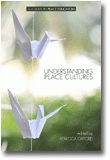
Understanding Peace Cultures
Edited by:
Rebecca L. Oxford, University of Maryland
A volume in the series: Peace Education. Editor(s): Laura L. Finley, Barry University.
Published 2014
Understanding Peace Cultures is exceptionally practical as well as theoretically grounded. As Elise Boulding tells us, culture consists of the shared values, ideas, practices, and artifacts of a group united by a common history. Rebecca Oxford explains that peace cultures are cultures, large or small, which foster any of the dimensions of peace – inner, interpersonal, intergroup, international, intercultural, or ecological – and thus help transform the world. As in her earlier book, The Language of Peace: Communicating to Create Harmony, Oxford contends here that peace is a serious and desirable option.
Excellent educators help build peace cultures. In this book, Shelley Wong and Rachel Grant reveal how highly diverse public school classrooms serve as peace cultures, using activities and themes founded on womanist and critical race theories. Yingji Wang portrays a peace culture in a university classroom. Rui Ma’s model reaches out interculturally to Abraham’s children: Jewish, Christian, and Muslim youth, who share an ancient heritage. Children’s literature (Rebecca Oxford et al.) and students’ own writing (Tina Wei) spread cultures of peace.
Deep traditions, such as African performance art, Buddhism, Daoism, Confucianism and Islam, give rise to peace cultures, as shown here by John Grayzel, Sister Jewel (a colleague of Thich Nhat Hanh), Yingji Wang et al., and Dian Marissa et al. Peace cultures also emerge in completely unexpected venues, such as gangsta rap, unveiled by Charles Blake et al., and a prison where inmates learn Lois Liggett’s “spiritual semantics.” Finally, the book includes perspectives from Jerusalem (by Lawrence Berlin) and North Korea and South Korea (by Carol Griffiths) to help us envision – and hope for – new, transformative peace cultures where now there is strife.
CONTENTS
List of Figures. List of Tables. Acknowledgments. Part A Looking at Peace Cultures. Using This Book to Discover Peace Cultures, Rebecca L. Oxford. Better Than a Thousand Hollow Words: Speaking the Language of Peace Across Contexts and Cultures, Rebecca L. Oxford and Rebecca M. Boggs. Part B: Peace Education: Creating Small and Large Peace Cultures. Womanist and Critical Race Theory for Peacemaking in Multilingual, Multicultural Classrooms, Shelley D. Wong and Rachel A. Grant. The National Peace Essay Context: An Exploration in Peacebuilding through Transformative Peace Education, Jiemin (Tina) Wei. Peace Language for Abraham’s Children: A Peace Education Curriculum for Middle Eastern Youth Based on the Christian Bible, Rui Ma. A Teacher’s Journey: Integrating Peace Education into Language Classes, Yingji Wang. Part C: Creating Peace Cultures: Spiritual, Philosophical, Linguistic, and Literary Insights. Creating Peace, Speaking “Interbeing”: A Buddhist Perspective, Sister Jewel (Chan Chau Nghiem). Islamic Wisdom for Peace, Dian Nasrah Marissa, Rebecca L. Oxford, J. Edward Dotherow IV and Lauren Mackenzie. Chinese Language, Philosophy, and Wisdom of Peace, Yingji Wang, Ai Zhang, Ruifang Xu, and Jing Lin. Peace Talk: Learning Peace through “Spiritual Semantics”, Lois P. Liggett. Peace Lessons in Multicultural Literature for Children, Rebecca L. Oxford, Rebecca M. Boggs, Jennifer D. Turner, Rui Ma, and Chien-Yu Lin. Part D: Performing Art for Peace: Cultural Understandings for Peace Educators. African Performing Art: Language of Social Connectivity, Reconstruction, and Harmony, John A. Grayzel. Making Peace With Gangsta Rap: Themes and Paradoxes, Charles C. Blake III, Nathanael J. Rudolph, Rebecca L. Oxford, and Rebecca M. Boggs. Part E: Social and Political Perspectives: Challenges for Peace Educators and Peacebuilders. Sunset Over Jerusalem, Lawrence N. Berlin. Both Sides Now: Reflections on Korea, Carol Griffiths.
REVIEWS
"Thich Nhat Hanh (quoted in Quinn, 2014) describes the current human condition as a small boat on the stormy sea in which “we need people who can sit still and be able to smile, who can walk peacefully… [and] each of you is that person†(p. 1). The stillness inside can settle the turbulence outside, but this stillness must be cultivated in each particular person through education. Understanding Peace Cultures answers the call to demonstrate the craft of nurturing inner peace and creating peace cultures, inviting all to become that person." Hongyu Wang Oklahoma State University in Teachers College Record (Read full review)
-
Paperback9781623965051
Web price: $45.04 (Reg. 52.99)
-
Hardcover9781623965068
Web price: $80.74 (Reg. 94.99)
- eBook9781623965075

-
 Coronavirus and Vulnerable People
Addressing the Divide in Harm and Responses and Exploring Implications for a More Peaceful World
Coronavirus and Vulnerable People
Addressing the Divide in Harm and Responses and Exploring Implications for a More Peaceful World
-
 Experiential Learning in Higher Education
Issues, Ideas, and Challenges for Promoting Peace and Justice
Experiential Learning in Higher Education
Issues, Ideas, and Challenges for Promoting Peace and Justice
-
 Humanities Perspectives in Peace Education
Re-Engaging the Heart of Peace Studies
Humanities Perspectives in Peace Education
Re-Engaging the Heart of Peace Studies
-
 Lessons for Creating a Culture of Character and Peace in Your Classroom
A Playbook for Teachers
Lessons for Creating a Culture of Character and Peace in Your Classroom
A Playbook for Teachers
-
 Peace is Everyone's Business
Peace is Everyone's Business
-
 Teaching Peace Through Popular Culture
2nd Edition
Teaching Peace Through Popular Culture
2nd Edition
-
 The New Peace Linguistics and the Role of Language in Conflict
The New Peace Linguistics and the Role of Language in Conflict

